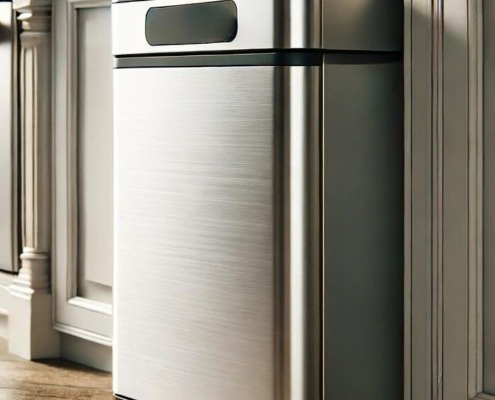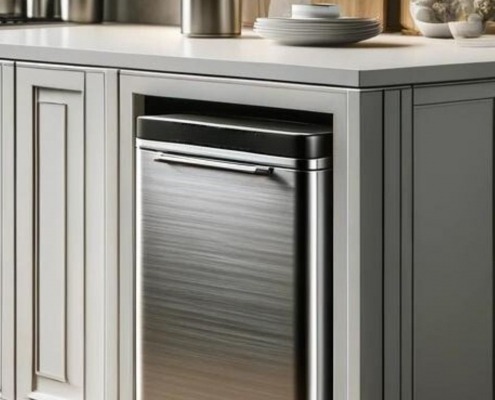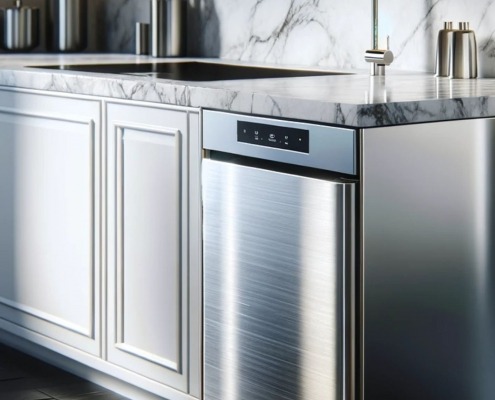Trash Compactor Won’t Start: Top 5 Reasons & Fixes (With Video!)
APP Expert / Monday July 25, 2022
Is your trusty trash compactor silent when you turn the knob? Before you rush into buying a new one, consider that a simple fix might be all it needs. Dive into our guide, complete with a helpful how-to video just below, and uncover the common culprits and solutions for getting your trash compactor back in action.
Need a replacement part for your trash compactor? Search below using your specific compactor model number to identify the exact part needed:
Trash compactor not starting when you turn the knob? You may think it’s time to shell out for a new appliance, but hold up! That might not be the case. Don’t be daunted by a stubbornly silent trash compactor. Often in instances like this, just one failed or malfunctioning component can gum up the whole works, stopping your compactor from smashing your trash completely.
In this guide, we’re going over five of the most common issues that might prevent your compactor from running. Keep reading to learn how to diagnose and fix your problem, and don’t forget to check out our video guide for some additional tips!
Before you begin…
For safety, make sure you disconnect your trash compactor from power either at the wall outlet or circuit breaker. By making sure your appliances are not receiving power before starting maintenance, you’re protecting yourself from a potentially nasty or even life-threatening shock.
Tools for the Job
While not every part we’re testing will need all of the tools below, you will need all of these tools to do a full diagnostic on your appliance:
- A multimeter that measures continuity, ohms, and potentially voltage
- A flathead screwdriver
- A putty knife
- A Phillips screwdriver (for basic Phillips screws) or nut driver (for hex-head screws) – whichever one you need to remove access panels on your specific model of trash compactor
- The compactor’s manual and tech sheet
- Work gloves
Once you’ve got your tool kit, it’s time to get to testing.
1. The Power Supply
Most trash compactors need 120V of power to work properly. Simply put, the compactor won’t run if it isn’t receiving sufficient power.
If this is your issue, it starts at either the circuit breaker or the outlet. Here’s how to check:
- Start by checking the circuit breaker to be sure it hasn’t tripped. Even if it doesn’t look like it’s tripped, reset it, just to make sure.
- Use a multimeter to test the voltage on the outlet. Set your multimeter to volts and put a probe into each terminal of the outlet. It should read at or around 120V – this number can fluctuate up or down by about 10%. If your outlet isn’t reporting the proper voltage, then either the outlet itself or your circuit breaker are the issue.
2. The On-Off Rotary Switch
The on-off rotary switch is a small switch found in the trash compactor’s control panel, actuated by a knob that is usually removable. When used in tandem with the knob or a button, it allows the user to turn the appliance on. If your trash compactor isn’t starting, it may be that the contacts on the switch have failed.
To check the switch, you’ll need a Phillips screwdriver and a multimeter. Let’s see how it’s done:
-
- Open up the front console. To do this, you’ll need to remove the screws along the bottom of the front console. If you’re having trouble tracking down the hardware that secures the front panel, try removing the compactor from beneath the counter and check along the sides and top.
- Get your multimeter and set it to continuity. We’ll be checking to see if the switch is able to carry an electrical charge. Touch your multimeter’s probes together and check the readout to make sure the multimeter is working.
- Refer to the wiring chart for your compactor’s on-off rotary switch. This may be in your appliance’s manual or a separate sheet of paper that came with the appliance. If you don’t have the paperwork that came with your compactor, you can generally find it all online. Just search for your trash compactor’s model number. Once you have the wiring chart, make note of which color wire goes where. You’re looking at the “START” wire, incoming power wire, and the “ON” wire. Our compactor’s incoming power wire is tan with a red stripe, “ON” is violet, and the “START” wire is yellow. Remember to check the wiring chart for your own compactor, as these colors may vary depending on the make and model of your appliance.
- Remove the wires from the terminals, making note of which one goes where.
- Test for the “ON” position: Attach one probe to the terminal for the incoming power wire and the other probe to the “ON” terminal. Turn the switch to the “ON” position. Check your multimeter, you should have continuity.
- Test for the “START” position: Attach one probe to the incoming power terminal and the other to the “START” terminal. Turn the switch to the “START” position and hold it there as it will want to spring back if you release it. Check your multimeter, you should have continuity.
- If your switch fails either of these continuity tests (5 and/or 6), it needs to be replaced.
3. The Drive Motor
Your trash compactor does its job by way of an electrical motor, which is usually found in the back of the appliance. It connects to and drives the appliance’s gear kit, which then transfers the motion to the trash compactor’s ram, crushing the garbage loaded into the bin. The motor also features a start switch at the top, which is what activates the motor when needed.
If your trash compactor won’t start, the motor or one of its internal components may have failed.
- Start by removing the compactor from the cabinets. You’ll need access to the back of the appliance, so take the drawer out completely and set it aside, then remove the compactor itself.
- Remove the rear access panel. At the back of the compactor, there should be a metal housing covering the motor. It’ll be held in place by a few Phillips or hex head screws. Use a nut driver or screwdriver to unthread these and remove the panel.
- With access to the motor, start by checking that the motor isn’t jammed. It should spin fairly easily by turning it with your finger. If you’re getting a lot of resistance, it may be jammed.
- A live voltage test can also be done to make sure that the compactor is sending voltage to the motor. This test does require some electrical knowledge, so if you are not confident or comfortable doing this yourself, you should call a technician. Check out our video above for a brief overview of how this test is done!
4. The Door Switch
The door switch is a safety device that prevents the compactor from running if the drawer isn’t pushed all the way in. It is generally found in the back of the compactor in the wall on the right hand side.
Like all other switch components, this part can potentially become stuck or fail outright, reporting to the control board that the drawer is open, even when it isn’t. If this is the case, your trash compactor won’t run.
To check the door switch, you’ll need Phillips and flathead screwdrivers and a multimeter.
- Remove the trash compactor drawer and set it aside.
- Next, remove the trash compactor from its space beneath the counter. Depending on your trash compactor’s model, you may need to remove a mounting bracket or simply lower the leveling feet to clear it from the space.
- Remove the access panel covering the door switch. You’ll find it on the exterior of the side the switch is on.
- Disconnect the wires. A flathead screwdriver can be used if they’re on too tight to be removed by hand.
- Set your multimeter to continuity and attach the probes to the switch. You’ll want to attach one probe to each of the switches that had a wire attached to it. Disregard the extra terminal if your switch has one. With the switch lever open, there should be no continuity.
- Reach into the trash compactor, press the door switch, and check your multimeter again. When the switch is pressed in, it should have continuity.
5. The Tilt Switch
The tilt switch is another safety component. It cuts power to the compactor and shuts it off if the door was opened during a cycle. It looks and functions very similarly to the door switch, signaling to the compactor’s control board when the door is closed, but is instead found on the front of the cabinet on the right hand side.
If your trash compactor isn’t starting, this switch may have failed. To test it, you’ll need a putty knife, flathead screwdriver, and a multimeter.
- Open or remove the trash compactor drawer.
- Pop the tilt switch out. Slide a flathead screwdriver under the seam on the right side to press the locking table that holds it in place, then use a putty knife on the left side to pry it out.
- Disconnect the wires, making note of where each one goes.
- Set your multimeter to continuity and attach the probes to the switch’s terminals. With the switch lever open, it should have continuity.
- Press the rocker arm in and check the multimeter again. It should not have continuity.
Finding The Right Replacement Part
Chances are, after running all these tests, you’ve tracked down something that needs to be replaced. Need some help finding a compatible replacement part? We’ve got you covered there, too!
Use your trash compactor’s model number, which you can find on a label somewhere on the appliance, to find a compatible replacement part. That label is most likely inside the unit somewhere, so start by opening the drawer and checking around the door and inside of the cabinet. If you can’t find a sticker, you can consult your compactor’s manual for at least a partial model number.
Once you have the model number, you can type it into our search bar at AppliancePartsPros.com to find a list of compatible parts. Order through us and you should have a genuine OEM replacement part in just a couple of days!
Wrapping Up
We hope our guide has helped you to get your trash compactor back in working order. If you’ve got any more questions, keep us in mind. Our help doesn’t end here! AppliancePartsPros.com has tips, tutorials, and genuine replacement parts for a wide variety of home appliances. Our friendly staff is on hand to help you track down the piece you need and install it properly yourself.
Stay connected with the latest DIY tips, tutorial videos, and repair guides by following us on Facebook, Instagram, and Twitter. We love hearing about your repair stories and successes. If you need more help or want personalized guidance, feel free to contact or call us at 877-477-7278. We’re ready to help you take on your next project with confidence!
Hi! I’m Matt H., and I’m thrilled to be your guide through the world of appliance repair with over 25 years of invaluable experience in the industry.
From the early days of my career, I have been deeply passionate about appliances and their inner workings. Over the years, I’ve seen it all – from vintage models to the latest cutting-edge technology – and I’ve dedicated myself to mastering the art of repair. With a toolbox in one hand and a wealth of knowledge in the other, I’ve tackled every challenge that has come my way, learning and growing with each repair.
Join me as we dive into the intricacies of appliance repair. From step-by-step repair guides to explanations of common problems and their solutions, I’ll be here to simplify the repair process and empower you with the knowledge you need to keep your appliances running smoothly.
Feel free to explore our blog, ask questions, and leave comments – this platform is a space for learning, sharing, and growing together. Let’s work together to ensure that your appliances continue to serve you for years to come.
Thank you for joining me on this journey, and I look forward to being your go-to resource for all things related to appliance repair!





